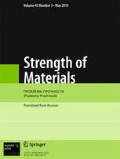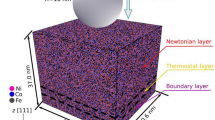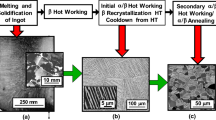The dislocation width and lattice resistance (Peierls stress) of a γ-TiAl alloy are calculated by the density ratio method. The lattice resistance is shown to decrease with the dislocation width. The relationship between the Peierls stress and dislocation width variation is defined by theoretical derivation. The yield stress is negatively correlated with the shear stress of the material. It can become a useful tool for choosing an appropriate shear stress under deformation.




Similar content being viewed by others
References
Z. Wu, R. Hu, T. Zhang, et al., “Microstructure determined fracture behavior of a high Nb containing TiAl alloy,” Mater. Sci. Eng. A, 666, 297–304 (2016).
H. Clemens and S. Mayer, “Design, processing, microstructure, properties, and applications of advanced intermetallic TiAl alloys,” Adv. Eng. Mater., 15, No. 4, 191–215 (2013).
R. C. Feng, Z. Y. Rui, G. T. Zhang, “Improved method of fatigue life assessment for TiAl alloys,” Strength Mater., 46, No. 2, 183–189 (2014).
M. Terner, S. Biamino, D. Ugues, et al., “Phase transitions assessment on γ-TiAl by Thermo Mechanical Analysis,” Intermetallics, 37, 7–10 (2013).
Y. Ma, D. Cuiuri, N. Hoye, et al. “The effect of location on the microstructure and mechanical properties of titanium aluminides produced by additive layer manufacturing using in-situ alloying and gas tungsten arc welding,” Mater. Sci. Eng. A, 631, 230–240 (2015).
S. Tian, X. Lv, H. Yu, et al.,“Creep behavior and deformation feature of TiAl–Nb alloy with various states at high temperature,” Mater. Sci. Eng. A, 651, 490–498 (2016).
M. Kanani, A. Hartmaier, and R. Janisch, “Stacking fault based analysis of shear mechanisms at interfaces in lamellar TiAl alloys,” Acta Mater., 106, 208–218 (2016).
J. L. Su and X. F. Lian, “Relationship between intrinsic characteristic sizes of elastic property and plastic property of γ-TiAl based alloy,” Chinese J. Nonferr. Metal., 25, No. 2, 338–343 (2015).
J. C. Schuster and M. Palm, “Reassessment of the binary Aluminum-Titanium phase diagram,” J. Phase Equilib. Diff., 27, No. 3, 255–277 (2006).
E. Oren, E. Yahel, and G. Makov, “Dislocation kinematics: a molecular dynamics study in Cu,” Model. Simul. Mater. Sc., 25, No. 2, 025002 (2017).
Z. Li, N. Mathew, and R. C. Picu, “Dependence of Peierls stress on lattice strains in silicon,” Comp. Mater. Sci., 77, 343–347 (2013).
G. Liu, X. Cheng, J. Wang, et al., “Improvement of nonlocal Peierls–Nabarro models,” Comp. Mater. Sci., 131, 69–77 (2017).
G. T. Zhang, Z. Y. Rui, R. C. Feng, et al., “Illustration of fracture mechanism in high temperature for TiAl alloys,” Appl. Mech. Mater., 457–458, 19–22 (2014).
L. Wang, “Calculation of the interplanar spacing of cubic crystal lattice,” J. Yunnan Nat. Univ., 24, No. 4, 346–348 (2015).
R. C. Feng, J. T. Lu, H. Y. Li, et al., “Effect of the microcrack inclination angle on crack propagation behavior of TiAl alloy,” Strength Mater., 49, No. 1, 75–82 (2017).
D. Hull and D. J. Bacon, Introduction to Dislocations, Butterworth-Heinemann (2011).
R. E. Schafrik, “Dynamic elastic moduli of the titanium aluminides,” Metall. Trans. A, 8, No. 6, 1003–1006 (1977).
K. Tanaka, K. Okamoto, H. Inui, et al., “Elastic constants and their temperature dependence for the intermetallic compound Ti3Al,” Philos. Mag. A, 73, No. 5, 1475–1488 (1996).
D. François, A. Pineau, and A. Zaoui, Mechanical Behaviour of Materials, Springer, Dordrecht (1998).
H.-D. Dietze, “Die Temperaturabhängigkeit der Versetzungsstruktur,” Z. Phys., 132, No. 1, 107–110 (1952).
J. N. Wang, “Prediction of Peierls stresses for different crystals,” Mater. Sci. Eng. A, 206, No. 2, 259–269 (1996).
Acknowledgments
This work was supported by a grant from the National Science Foundation of China (No. 51665030) and the Program for ChangJiang Scholars and Innovative Research Team in University of Ministry of Education of China (No. IRT_15R30) and Doctoral research Foundation of Lanzhou University of Technology. The authors wish to thank Engineering Research center of Nonferrous Metallurgy’s New Equipment, Ministry of Education, Lanzhou University of technology for providing help.
Author information
Authors and Affiliations
Corresponding author
Additional information
Translated from Problemy Prochnosti, No. 1, pp. 65 – 71, January – February, 2019.
Rights and permissions
About this article
Cite this article
Feng, R.C., Li, L.L., Li, H.Y. et al. Calculation of the γ-TiAl Lattice Resistance. Strength Mater 51, 56–61 (2019). https://doi.org/10.1007/s11223-019-00049-w
Received:
Published:
Issue Date:
DOI: https://doi.org/10.1007/s11223-019-00049-w




